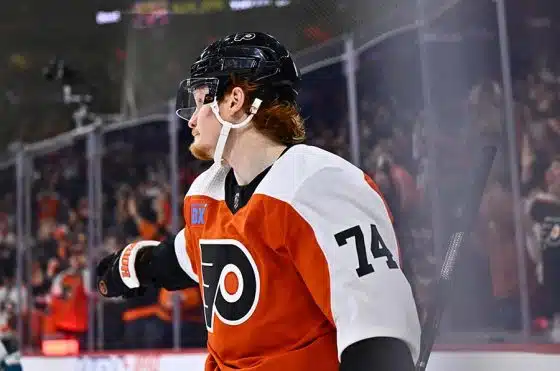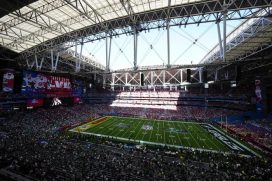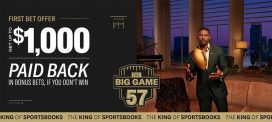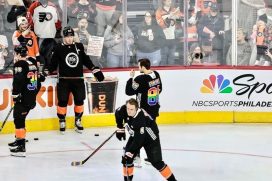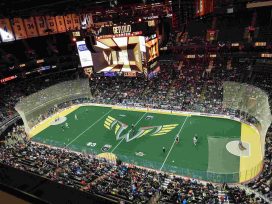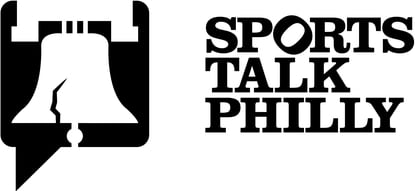(Note: This article originally appeared on Seventeenrings.wordpress.com)
The Sixers should pass on the freshman sensation from Duke, but he will end up being one heck of a consolation prize for the Los Angeles Lakers.
Patrick Causey, on Twitter @pcausey3
12 months ago, the notion that Brandon Ingram could be the top pick in the NBA draft seemed as far fetched as Donald Trump securing the Republican nomination. But Ingram has rocketed up draft boards after an impressive run on the AAU circuit and downright sensational freshman season at Duke.
The Kinston, North Carolina native is everything that the modern NBA embodies: length, athleticism, and the ability to shoot from deep. Add in humility and a work ethic that parallels some of the best in the game, and it's easy to see why some draft experts prefer Ingram over Ben Simmons, the prohibitive favorite to go number one overall.
But I just don't see the elite athleticism from Ingram to believe that he will ever be a top 5 player in the league, which is why I have him ranked behind Ben Simmons as the second best player in this draft (although Providence's Kris Dunn is not far behind).
It is also why I think the comparisons to Kevin Durant — while understandable given the similarities in their physical profile and game — are wholly unfair. Even his most ardent supporters acknowledge that Ingram is essentially a poor man's Durant, which is impressive in its own right but likely to disappoint anyone that is expecting Ingram to live up to Durant's lofty status.
In other words, I peg Ingram as a perennial All-Star in the mold of Paul George — a top 10-15 player around which you can build a championship contender. Just not a guy that will consistently be in the MVP discussion.
Here is a breakdown of Ingram's strengths and weaknesses:
| Strengths | Weaknesses |
| Shot 41% from 3 point range | Needs to add bulk to his frame |
| Long frame: 6'9 height but absurd 7'3 wingspan | Not an explosive or fluid athlete |
| Good handle and passing ability; can fill in as a point forward | Shot 68% from the free throw line, raising concerns about whether his shot translates to the NBA level |
| Crafty at getting to the rim, not afraid of contact, attacks the rim with intensity | Tendency to lose focus on defense |
| Versatile defender | |
| Very competitive; considered a great teammate |
STRENGTHS
Shooting
Ingram's game starts and ends with his ability to shoot. While Ingram shot an impressive 46% from two-point range and 41% from three last year, a closer look at his shot chart paints an interesting picture (chart courtesy of ShotAnalytics.com):
As you can see, Ingram excelled shooting from the top of the key and left side of the court, while he struggled mightily shooting on the right side. I did not see anything in the game film that explained this stark contrast in results. My guess is that this is static from a one season sample size, but it is something to keep an eye on. If this continues, defenders at the NBA level will be able to limit Ingram's effectiveness on offense by forcing him to his right.
Big picture, Ingram can beat defenses with his shooting in a number of ways. His quick, fluid release makes him a threat in catch and shoot opportunities, where he connected on 42% of his shots on the year. According to DraftExpress.com, that ranked him third among all draft prospects, behind only Buddy Hield and Jamal Murray:
But Ingram isn't just a spot up shooter. He has also flashed the ability to shoot off the dribble as well.
Ingram's jump shot is also effective in isolation settings, where he scored .94 points per possession. Kevin Durant, a player with whom Ingram is most often compared, scored only .88 points per possession during his freshman year at Texas.
Ingram's shot makes him a difficult player to guard, because it opens things up for him to attack the rim. While his handle needs work — he often has the ball too high and far from his body — he was effective getting to the rim by using a pump fake and taking advantage of his freakish length:
Notice that North Carolina's Brice Johnson is covering Ingram on both plays. I did this on purpose to highlight how Ingram's shooting puts defenders on their heels.
On the first play, Johnson gave Ingram space, daring him to shoot. Ingram obliged and nailed the three. Later in the game (second clip), Johnson closed out on Ingram's pump fake, which opened up the lane for an easy lay-in.
Ingram's ability to shoot and drive puts enormous pressure on defenses, and also creates spacing for his teammates. Without question, this combination is the most attractive aspect of Ingram's game, and will allow him to fill in seamlessly at the NBA level, regardless of the offense he ends up playing in.
Incredible Length
Brandon Ingram is 6'9, but has a freakish 7'3 wingspan. While Ingram is not an elite athlete, he uses his length to help on both ends of the floor. On offense, Ingram mitigates his lack of explosion by using his long arms to create the separation above his defenders. With his go-to finger roll move conjuring up memories of George "The Iceman Gervin."
On the defensive side of the ball, Ingram's length is a blessing and a curse. It allows him to make up ground in breathtaking fashion, but also encourages spouts of laziness as well. It worked at the collegiate level, but he won't be able to get away with it in the NBA.
According to SI.com, only four players with a wingspan of at least 7'2 wingspan attempted at least 5 threes per game while shooting 40% since 2001-02:
- Brandon Ingram: 6'9, 7'3 wingspan, 41% from 3
- Robert Covington: 6'7, 7'2, 43.8%
- Kevin Durant: 6'10, 7'4.75, 40.4%
- Gary Flowers: 6'7, 7'4.5, 40.3%
Obviously these results are all over the map. Durant needs no introduction. But I had no earthly idea who Gary Flowers was when I saw this statistic. And I likely would have only been vaguely familiar with Robert Covington if he wasn't plying his trade for the hometown team. In other words, his combination of length and shooting is indeed impressive, but it is by no means a guarantee for NBA success.
Hustle/Second Chance Points
Ingram isn't just a tall dude that can stroke it from deep. He brings a lot to the table if you watch him long enough.
One thing that stood out while breaking down the film was how often Ingram followed his own shot and got an easy bucket from just out hustling his defender.
Full disclosure: I am a sucker for hustle plays. Maybe it's the byproduct of being a coaches son. But I saw Ingram pull this off at least once a game, and it really got me excited about what it could do during critical situations in a game.
Second chance points can turn the tide of a game, especially down the stretch. It gives the offense more opportunities to score, requires the opponent to extend energy on defense for another 24 seconds, and eventually, and can break their spirit.
I love that Ingram brings this level of tenacity every game. It's infectious, and helps build a winning culture, especially when its coming from one of your best players.
Driving and Finishing with Contact
I touched on this earlier, but wanted to expand on Ingram's ability to get to the rim a little more. It bears repeating that Ingram is not a prolific ball handler, but he has a sneaky array of moves to attack defenders off the dribble. One of his go-to moves was the spin move, which he uses to manufacture separation that he otherwise cannot create given his lack of explosiveness:
Despite needing to add more weight, Ingram did not shy away from contact at the rim. I was surprised at how well he was able to finish with contact. That will only improve as Ingram adds more weight under the tutelage of NBA strength and conditioning coaches.
Defensive Potential
The key word here is potential. Ingram was not a lock down defender in college, but he flashed the potential become one and flashed enough versatility to guard multiple positions.
As I mentioned before, Ingram's greatest asset on the defensive side of the ball is his length. Even when he was beat, he was able to recover easily given his absurd 7'2 wingspan
When Ingram was locked in — which didn't always happen — he was able to stick with smaller guards on the permitter. In other words, he doesn't project to be a Kevin Love like liability on the defensive side of the ball. With a league wide emphasis on being able to defend the pick and roll and guard multiple positions, Ingram's length and defensive versatility will be an asset for any team.
WEAKNESSES
There is so much to like about Ingram's game that it is hard to come up with some areas of concern. To me, none of these issues are fatal. I don't think they will prevent Ingram from becoming an effective NBA player, I simply see them as having the potential to prevent him from becoming one of the elite of the elite.
There are four primary concerns I see in Ingram's game: 1. Lack of elite athleticism, 2. Lack of bulk, 3. Bad shot taking, and 4. Losing concentration on defense. Let's break this down further.
Lack of Elite Athleticism
One of the main reasons I think the Kevin Durant comparisons are unfair is that Ingram is nowhere near the athlete that Durant is. This isn't to say Ingram is a bad athlete; he's not. He is just not an elite athlete, and that will create problems for him at the NBA level.
The biggest concern for me is his lack of explosiveness. He's not a "quick twitch" or "fluid" player, and that stood out most when he struggled to beat defenders around the edge:
The good news is that some of this will improve as Ingram fills out his frame and works on improving his explosiveness. Steph Curry, Kevin Love and JJ Reddick all reinvented their bodies when they got to the NBA thanks to proper training and diet. I expect to see similar improvement from Ingram, but I don't think he will ever approach the upper echelon of NBA athletes, which in turn will likely prevent him from being considered a top 5 player in the league.
Lack of Strength
I am actually less concerned about Ingram's lack of strength than most, largely because I think it is an issue that will be fixed over time. But everyone else talks about it, so why the hell not.
Ingram does not have a narrow frame like North Carolina's Brice Johnson or the Sixers Nerlens Noel. Ingram's broad shoulders tells me that — assuming he puts in the work — he won't have any issues adding on another 20-30 lbs of muscle over the next 3-5 years.
But until he does, Ingram will struggle at times on the defensive side of the ball. Larger defenders will be able to manhandle Ingram on the block, where Ingram just won't have the strength to keep them out of the paint:
Ingram should also expect to see a healthy dose of picks early in his career. His lack of strength prevented him from working through screens set by larger defenders in college, and NBA coaches will be sure to run him through as many screens as possible until he can prove that he can fight through screens effectively:
But again, I am not overly concerned. I don't see this is a long term problem, only something that will inhibit Ingram's productivity during the first 2-3 years of his career.
Loses Focus on Defense
By all accounts, Ingram works his ass off and is a tough competitor. Which is why I have a hard time understanding why he struggled at times with his focus on the defensive side of the ball.
Part of this is likely the fact that Ingram is 18 years old, and like most 18 year olds, he has the attention span of a goldfish. But I saw it enough during the season to give me pause for concern.
This issue reared its head most often when Ingram was playing off the ball defense. His awareness off the ball was alarming, and I did not see it improve much during the season
The NBA season is a grind. 82 games can take a toll on not only your body, but also your sanity. How is Ingram going to react defensively on a Tuesday night game in the middle of December against Milwaukee? Again, I am nitpicking here; but when you are grading guys at the top, the minor details matter.
Poor Shot Selection
I want to preface this by saying Ingram is not a gunner that chucks up 10 bad shots a game. So we aren't talking J.R. Smith here. But Ingram does have a tendency to force things on offense at times:
I noticed this more down the stretch of the season when Coach K gave Ingram more freedom to freelance on offense. While it mostly worked out in Duke's favor, Ingram would occasionally try to do too much, and it ended in some ill-advised shots.
A separate, but related issue showed up with Ingram's off the ball movement (maybe we are onto something here). There were too many times that I saw Ingram standing stationary at the top of the key with his hands out waiting for his teammate to pass him the ball. That lack of movement can suffocate an offense and undermine the spacing that his shooting naturally provides.
CONCLUSION
If the Sixers had landed the second pick in the draft, Brandon Ingram would have been a heck of a consolation prize. His length and shooting are an ideal fit for the modern NBA, he is a heck of a competitor, and would provide the Sixers with some much needed floor spacing. But I have reservations about whether Ingram will ever truly become a top 5 NBA player, which is why I think the Sixers are better served drafting Ben Simmons.


